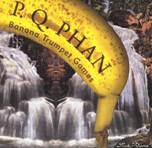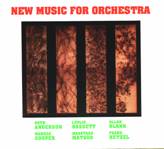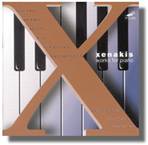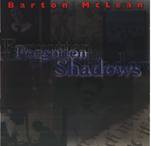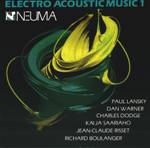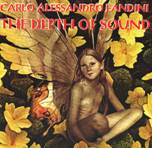Publications
The Clarinet of the Twenty-First Century DVD (DVD movie, DVD-Rom, DVD companion booklet - Exercises for the Production of New Sounds)
The Clarinet of the Twenty-First Century Website - http://www.research.umbc.edu/~emrich/clarinet21.html
The Clarinet of the Twenty-First Century (2nd edition; 458 pages), with 14 companion CDs
Etudes and Exercises for the Clarinet of the Twenty-First Century (175 pages), with companion CD
The Bass Clarinet of the Twenty-First Century (2nd edition; 141 pages), with 6 companion CDs
The E-flat Clarinet of the Twenty-First Century (2nd edition; 136 pages), with 3 companion CDs
The Clarinet of the Twenty-First Century is a multimedia package (audio clips, video clips, interactive website, written text and music) that contains information on new sonic resources for soprano (Bb), bass, and e-flat clarinet in the form of more than 900 pages of text, illustrated by more than 300 examples and charts by the author and from music since 1960 by almost 100 composers from throughout the world. More than 1000 sound files are available on 23 CDs or as MP3 downloads, as are more than 75 etudes and exercises written by the author to help the clarinetist learn to produce these sounds. A DVD movie (with companion booklet) and DVD-ROM (both on one disc) are also available that present a significant portion of this material in text, visual stills, video clips, audio clips, and links to references and websites of publishers, composers, and other areas of interest for today's clarinetist. This website is linked from the DVD in order to provide updated research pertinent to the project. In sum, The Clarinet of the Twenty-First Century documents 538 alternate fingerings, 1200 multiphonics, 1042 microtones, 71 multiphonic trills, and numerous other sounds and techniques.
The Clarinet of the Twenty-First Century is a valuable resource for not only professional and advanced clarinetists and composers, but for clarinet teachers and students, as well. Music written during the last forty years has especially challenged clarinetists to master new techniques and sounds in order to expand the expressive capabilities of their instrument. Much of what players learn through this process can also be applied to mastering the language of the standard literature (alternate fingerings is one example), and towards developing a stronger basic technique – smoother legato, and greater control of tone and phrasing nuances. Most importantly, learning to produce extended techniques improves listening skills and opens one's musical imagination.
Objectives
1) to expand the sonic resources of the clarinet based on peculiarities of its acoustical design (including a history of the evolution of its design since c. 1839) and of its current performance tradition: a wedding of theory and practice. The need for this approach has been especially supported by my experience in performing or reading countless new works that utilize new techniques for the clarinet in an awkward fashion, or that do not take musical advantage of some inherent strengths of the instrument. Charts of new sounds have been included, based on acoustical principles of the clarinet. I hope that this approach will help to overcome the idiosyncratic and empirical nature of earlier studies.
2) to present suggestions to composers for use of extended techniques in appropriate musical contexts. These are illustrated by musical examples (represented by notated scores and sound recordings) from a variety of works written since 1960 (with an abundance of works since 1985 by Asian composers), and by musical examples that I have composed. My goal in these illustrations has been to avoid recipes for musical compositions or suggestions of rigid limitations.
3) to present progressive exercises and etudes (more than 50 exercises and 30 etudes) to lead the clarinetist towards gaining facility with these new techniques/sounds. Learning is prescribed through written descriptions, and illustrated with aural (audio sound files) and visual (DVD) examples. I have attempted to coordinate as closely as possible the methods of learning extended techniques with methods of learning more familiar conventional techniques.
--------------------------------------------------
The E-flat Clarinet of the Twenty-First Century (2000)
The Bass Clarinet of the Twenty-First Century (1996) The Clarinet of the Twenty-First Century (1992)
--------------------------------------------------------------------------------------------- Music of Japan Today -
ed. by E. Michael Richards & Kazuko Tanosaki
(Cambridge Scholars Publishing, UK)
http://www.c-s-p.org/Flyers/Music-of-Japan-Today1-84718-562-2.htm
Music of Japan Today examines cross-cultural confluences in contemporary Japanese art-music through multiple approaches from twenty international composers, performers, and scholars. Like the format of the MOJT symposia (1992-2007) held in the United States, the book is in two parts. In Part I, three award-winning Japanese composers discuss the construction of their compositional techniques and aesthetic orientations. Part II contains nineteen essays by scholars and creative musicians, arranged in a general chronological frame. The first section discusses connections of the music and ideas of Japanese composers during the time surrounding the Second World War to Japan's politics; section two presents recent perspectives on the music and legacy of Japan's most internationally renowned composer, Toru Takemitsu (1930-96) . Section three investigates innovative, cross-cultural uses of Japanese and Western instruments (grouped by common instrumental families - voice, flutes, strings), shaped by historical traditions, physical design, and acoustic characteristics and constraints. Section four examines computer music by mid-career composers, and the final section looks at four current Japanese societies, within and “off-shore” Japan, and their music: spirituality and wind band music in Japan, avant-garde sound artists in Tokyo, Japanese composers in the UK, and the role of cell phone ringtones in the Japanese music market.
Table of Contents:
Part I: Composer Lectures and Discussions
Chapter One: Swaying Sensation and Fragile Beauty [Hiroyuki Itoh]
Chapter Two: Hiroyuki Itoh's String Quartet : Form, Style, and Content [David Pacun]
Chapter Three: My Compositional Technique and Thoughts on the Ambiguity of Sound [Hiroyuki Yamamoto]
Chapter Four: Syncretism in Cross-Cultural Ensembles [Shirotomo Aizawa]
Part II: Essays on Contemporary Japanese Music
Section One: Politics and Music: Japan , World War II, and its Aftermath
Chapter Five: Style and Politics in Kosaku Yamada's Folksong Arrangements, 1917-1950 [David Pacun]
Chapter Six: A Japanese Zero-Hour? – Postwar Music and the “Re-making” of the Past [Fuyuko Fukunaka]
Section Two: Beyond Tradition: Recent Perspectives on Toru Takemitsu's Music and Legacy
Chapter Seven: Toru Takemitsu and the Japanese Sound of Sawari [Mitsuko Ono]
Chapter Eight: Excursions into Takemitsu's Japanese Garden: An Application of the Superset/Subset Network to the Analysis of Three Orchestral Compositions [Hideaki Onishi]
Chapter Nine: Music in the Bathtub: Reading Takemitsu's Music Through Western Criticism [Peter Burt]
Section Three: Cross-Cultural Uses of Japanese and Western Instruments
Voice
Chapter Ten: Structural Integration of Television Phenomena in Joji Yuasa's Observations on Weather Forecasts [Colin Holter]
Chapter Eleven: Confluences of Vocal Techniques in Koji Nakano's Time Song II: Howling Through Time [Stacey Fraser]
Flutes
Chapter Twelve: Composing for the Shakuhachi [Marty Regan ]
Chapter Thirteen: Beyond Imitation: Extended Techniques in the Solo Flute Works of Toshio Hosokawa [Antares Boyle]
Strings and Piano
Chapter Fourteen: Composing for the 21-String Koto [Marty Regan]
Chapter Fifteen: Adaptation of Performance Style from Early Modern Japan to the Contemporary Cello [Hugh Livingston]
Chapter Sixteen: Ma (Sense of Time) as Compositional Tool [Airi Yoshioka]
Chapter Seventeen: Concepts of Cosmos and Temporality Within Joji Yuasa's Cosmos Haptic II for Piano [Kazuko Tanosaki]
Performer/Composer Collaboration
Chapter Eighteen: The Clarinet of the Twenty-First Century and Recent Music by Japanese Composers [E. Michael Richards]
Section 4: Mid-Career Japanese Composers and their Work With Computer Music
Chapter Nineteen: Recent Computer Music by Japanese Composers in Japan, America, and Europe [E.Michael Richards]
Section 5: Four Japanese Societies and their Current Music: Communities Within Japan, and “Offshore” Japan
Chapter Twenty: Alchemy of Brass: Spirituality and Wind Music in Japan [David Hebert]
Chapter Twenty-One: Sonorous Bodies [Yann Leblanc]
Chapter Twenty-Two: Identity Tactics of Japanese Composers in the Multicultural UK [Yumi Hara Cawkwell]
Chapter Twenty-Three: Ring My Bell: Cell Phones and the Japanese Music Market [Noriko Manabe]
----------------------------------------------------------------------------------------
Articles:
"Music of Japan Today: Examining Hidden Orders of Tradition" - Asia-Pacific Exchange Journal (December 1995, Vol 2, No. 2) online journal (http://leahi.kcc.hawaii.edu/pub/apexj/)
"Music of Japan Today II: Tradition and Innovation" - Ongaku Geijutsu [ The Art of Music ] - August 1994, p. 87-9 – co-authored with Kazuko Tanosaki [ Tokyo ]
"Microtone Chart for Clarinet" - Pitch (Spring 1990, Vol. 1 No. 4) [AFMM, New York ]
"Bring Back the C Clarinet!" - NACWPI Journal , Spring 1985, p.20-3 [Northeast Missouri State University , Kirksville ]
"The Realization of Pousseur's Madrigal I: A Valuable Methodology for Developing Performer Creativity and Musicality Through Controlled Improvisation" - Woodwind, Brass and Percussion , Part I: Feb. 1985, Vol 24, No. 2 (p.17-8), and Part II: March 1985, Vol. 24, No. 3 (p.14-6, 24) [Evans Publications, Deposit, NY]
|

